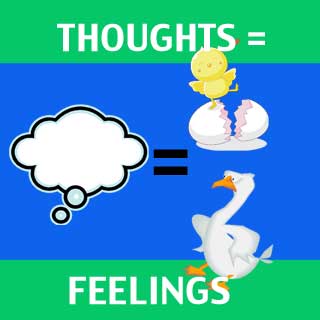“It’s been proven that the thoughts we choose have everything to do with our emotions. I can tell you that a commitment to feeling good can take away a stomach ache, fear, depression, sadness, anxiety—you name it. Any stress signal is a way of alerting you to say the five magic words: I want to feel good.” ~ Wayne Dyer
A commitment to feeling good. What does that look like? And how do I choose my thoughts so that I change how I feel? Don’t my thoughts and my feelings just pop up, out of my control?
I used to think that. But after immersing myself in works by Wayne Dyer and other authors, I’m beginning to change my tune and realize that I do have a choice, though it isn’t always easy.
Lately I’ve been catching myself when I feel down, annoyed or am experiencing some other negative emotion. I ask myself: What were you thinking just then? What went through your mind? I can usually identify it and that enables me to shift to a thought that makes me smile or, at the very least, feel a little less down or annoyed.
This journey with my mom has reminded me how much my thoughts affect my outlook and attitude. If I go down the “Why didn’t I spend more time with her in the past?” or “Why didn’t she go to the doctor sooner?” road, I feel sad, regretful and angry.
It’s not that I want to avoid my feelings or deny them. Sometimes it’s vitally important to feel those feelings, to sit with them, to experience them fully so we can move through them. Other times—and this is what happens more often with me—the feeling and the thought behind it are familiar (too familiar), following an old pattern that I’d like to interrupt because it doesn’t serve me or teach me anything anymore. I’m starting to recognize the difference between these kinds of feelings and responding to them accordingly.
Personal Example
Thought: “Why didn’t she go to the doctor sooner?”
Feeling: Anger, resentment.
Attitude/Action: Inability to enjoy my time with her.
Chosen Thought: I’m so grateful to have this hour with my mom.
New Feeling: Happiness, appreciation.
New Attitude/Action: Openness to share stories and time together.
Professional Example
Thought: I’m not talented enough to write this book.
Feeling: Discouragement.
Attitude/Action: Procrastination or no action at all.
Chosen thought: This is a great idea for a book. Look how much you’ve improved as a writer. You can do this!
New Feeling: Excitement and anticipation.
New Attitude/Action: I can’t wait to get started! (and I actually do–woop!)
What about you? Have you connected your thoughts to your feelings? If so, what are your strategies for making a shift if you want to change your feelings?




